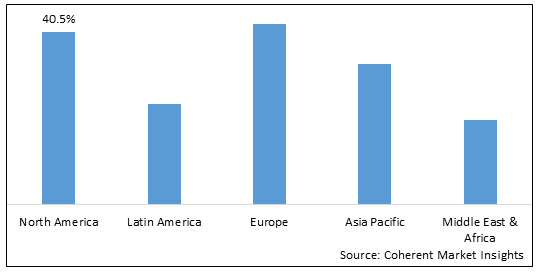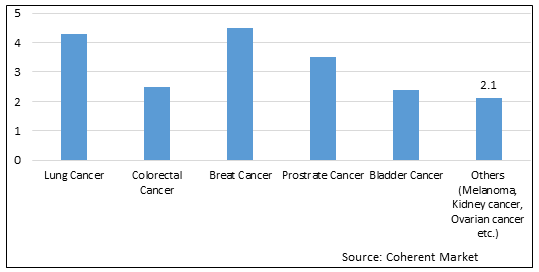Tumor Microenvironment Market is estimated to be valued at USD 1.87 Bn in 2025 and is expected to reach USD 4.37 Bn in 2032, exhibiting a compound annual growth rate (CAGR) of 12.9% from 2025 to 2032.
The tumor microenvironment refers to the surrounding cellular environment in which the tumor exists, including surrounding blood vessels, immune cells, fibroblasts, bone marrow-derived inflammatory cells, lymphocytes, signaling molecules, and the extracellular matrix. The tumor microenvironment plays a significant role in the progression, surveillance, and metastasis of cancer. Key drivers include the rising prevalence of cancer, increasing research in biomarkers and drug discovery, and growth in government funding for cancer research.
The tumor microenvironment market is segmented by cancer type, target, therapy, end user, and region. By cancer type, the lung cancer segment accounted for the largest share in 2022. The large share of this segment can be attributed to the recurrent use of consumables in various research activities.
Tumor Microenvironment Market Regional Insights
- North America is expected to be the largest market for the tumor microenvironment market during the forecast period, accounting for over 40.5% of the market share in 2025. The growth of the market in North America is attributed to the high adoption of advanced technologies, government funding for life science research, and the presence of major pharma and biotech companies.
- The Europe market is expected to be the second-largest market for the tumor microenvironment market, accounting for over 29.3% of the market share in 2025. The growth of the market is attributed to the increasing prevalence of cancer, favorable government initiatives, and a growing focus on personalized medicine.
- The Asia Pacific market is expected to be the fastest-growing market for the tumor microenvironment market, with a CAGR of over 16.2% during the forecast period. The growth of the market in Asia Pacific is attributed to the improving healthcare infrastructure, large patient pool, and rising awareness about advanced diagnostic technologies.
Figure 1. Global Tumor Microenvironment Market Share (%), by Region, 2025

To learn more about this report, Download Free Sample
Tumor Microenvironment Market Drivers:
- Increasing prevalence of cancer worldwide: According to the article published by the National Center for Biotechnology Information (NCBI), 2021, the cancer incidence rates are rising globally, with an estimated 19.3 million new cases in 2020. This can be attributed to factors like growing elderly population, changing lifestyles, and increased exposure to cancer risk factors. The rising cancer burden is expected to drive research into the tumor microenvironment to understand disease progression and develop better diagnostics and therapies. For instance, as per Globocan 2020 estimates, breast cancer is now the most commonly occurring cancer worldwide, with over 2.2 million new cases. Such high prevalence will necessitate greater focus on the tumor microenvironment to develop targeted breast cancer therapies.
- Technological advancements in tumor microenvironment analysis: Recent advances in tissue imaging, multiplexing, spatial biology, single-cell analysis, and big data analytics are revolutionizing the study of tumor microenvironments. For example, multiplexed ion beam imaging (MIBI) can analyze up to 100 protein markers in Formalin-Fixed Paraffin-Embedded (FFPE) tissue samples. Spatial transcriptomics can map the gene expression of thousands of genes in tissue samples. These advanced technologies are enabling high-plex, high-resolution mapping of tumor microenvironments to identify novel prognostic biomarkers and therapeutic targets.
- Growth in research funding and investments: Increasing funding for cancer research by governments, non-profits, and pharmaceutical companies is facilitating greater research and development into the tumor microenvironment. The U.S. National Cancer Institute's budget for 2021 was US$ 6.61 billion. The Moonshot initiative aims to accelerate cancer research. The goal of the Cancer Moonshot Scholars program is to encourage and support the next generation of scientists and health innovators focused on breakthroughs that will make a difference for patients and drive progress. Large pharma companies like Roche, Merck, Novartis, etc. are also aggressively investing in oncology research. Moreover, many startups have raised huge financing, like Gritstone (US$ 312 million) and others for immuno-oncology, tumor microenvironment research.
- Emerging role of tumor microenvironment in immuno-oncology: The tumor microenvironment is being explored as a key enabler of immunotherapies like checkpoint inhibitors. Analyzing immune cell interactions in the TME can help predict patient responses to I-O drugs. Companies are developing immunotherapies and drug combinations targeted at components of the TME like fibroblasts, macrophages, blood vessels, etc. Several candidates targeting T cell inflammation, suppressive macrophages, etc. are under clinical evaluation.
Tumor Microenvironment Market Opportunities:
- Combination therapies targeting tumor microenvironment: Focus on synergistic drug combinations and multi-targeted therapies to improve patient outcomes in cancer. For example, combination therapies are targeting both cancer cells and immune microenvironment, like PD-1 and PARP inhibitors. Another approach is developing conjugated hybrid biomolecules targeting multiple disease drivers in the TME. Such rational combination regimens based on tumor microenvironment analysis offer significant opportunities.
- Adoption of AI and machine learning: AI and machine learning have potential for high-dimensional analysis of tumor microenvironments using radiomics, pathological images, multi-omics data, etc. AI can identify novel morphometric, spatial, cooperative, and functional features. This can enable precise characterization of the TME and prediction of outcomes. Companies like PathAI, QuPath, Paige, etc. are leveraging AI for tissue image analysis. Further adoption of AI will augment insights into the tumor ecosystem.
- Diagnostic and prognostic biomarkers: Molecular mapping of the cellular and non-cellular TME can help discover novel diagnostic, predictive, and prognostic cancer biomarkers. Genes, proteins, and signatures marking invasive potential, immunogenicity, angiogenic ability etc. can serve as biomarkers. For example, tumor mutational burden predicts response to I-O drugs. Biomarkers like tumor-infiltrating lymphocytes and PD-L1 expression predict immunotherapy outcomes. Their clinical validity and utility need to be established.
- Point-of-care assays and microfluidic platforms: Emerging microfluidic and multiplexed platforms like PELOPS, SMRTTM from Akadeum Life Sciences, etc. allow rapid decentralized analysis of biomarkers using low sample volumes. These can enable cost-effective and frequent tumor molecular profiling. POC assays measuring ctDNA, exosomes, circulating tumor cells, etc. from liquid biopsy samples will be valuable for non-invasive monitoring of tumor microenvironment dynamics.
Report Coverage
| Report Coverage | Details | ||
|---|---|---|---|
| Base Year: | 2024 | Market Size in 2025: | USD 1.87 Bn |
| Historical Data for: | 2020 To 2024 | Forecast Period: | 2025 To 2032 |
| Forecast Period 2025 to 2032 CAGR: | 12.9% | 2032 Value Projection: | USD 4.37 Bn |
| Geographies covered: |
|
||
| Segments covered: |
|
||
| Companies covered: |
Thermo Fisher Scientific, Illumina, Danaher Corporation, Merck KGaA, BD Biosciences, Promega Corporation, Bio-Techne Corporation, Bio-Rad Laboratories, F. Hoffmann-La Roche Ltd, QIAGEN N.V., Sartorius AG, PerkinElmer, Miltenyi Biotec, Cell Signaling Technology, BioLegend, Abcam, Takara Bio, Fluidigm Corporation, NanoString Technologies, 10x Genomics, Bethyl Laboratories |
||
| Growth Drivers: |
|
||
| Restraints & Challenges: |
|
||
Uncover macros and micros vetted on 75+ parameters: Get instant access to report
Tumor Microenvironment Market Trends:
- Spatial biology techniques: Spatial techniques like multiplexed ion beam imaging, imaging mass cytometry, CO-Detection by Indexing (CODEX), GeoMX Digital Spatial Profiler, and Imaging Mass Cytometry allow characterization of tumor architecture and interrelationships. Companies like Nanostring, Ionpath, Akoya, Fluidigm, etc. offer platforms for high-parameter tissue imaging. These techniques provide insights into immune contexture, cellular interactions, and functional organization inside tumors.
- Single cell analysis: Single cell sequencing and analysis facilitate deconvolution of cell heterogeneity within tumor microenvironments. Techniques like scRNA-seq, mass cytometry, and flow cytometry provide multi-parametric profiling of individual cells. Key trends are the development of high-throughput platforms, reduced costs, and streamlined workflows for single-cell analysis. For instance, 10x Genomics offers easy-to-use scRNA-seq systems like the Chromium Controller.
- Organ-on-a-Chip models: Microfluidic organ-on-chip models that recapitulate tumor dynamics are emerging as alternatives to animal models, allowing more realistic analysis of human tumors. These systems incorporate 3D tumor and stromal co-cultures, perfusable vasculature, and physicochemical gradients. Several companies, like CN Bio, Emulate, TissUse, Mimetas, etc., now offer organ-on-chip platforms for pharmaceutical research.
- Integrated in silico models: Computational modeling leveraging multi-omics data from bulk and single cell analysis can provide systems-level insights into tumor-host interactions. Integrated in silico models considering spatiotemporal changes can potentially guide therapeutic strategies. For instance, researchers at the international Society for Computational Biology (ISCB) developed a predictive modeling platform incorporating proteomics, transcriptomics, and morphometrics of the tumor microenvironment.
Tumor Microenvironment Market Restraints:
- Complexity and heterogeneity of tumor microenvironment: The tumor microenvironment is highly complex and dynamic, with cross-talk between diverse cell types and matrix components. Moreover, significant heterogeneity exists between patients, tumor types, and within tumor sites. This complexity and heterogeneity make it challenging to develop targeted therapies. Extensive, longitudinal profiling is required to characterize the intricacies of TMEs.
- Limitations of preclinical models: Conventional 2D culture and animal models often poorly simulate human tumor microenvironments. This can lead to poor clinical translation and highlights need for superior models like organoids, organ-on-chip, humanized mice. But these advanced models involve technical challenges, high costs. Overall, limitations of preclinical TME models remain a barrier.
- Lack of qualified personnel: The interdisciplinary field of tumor microenvironment research requires expertise in biology, clinicians, bioinformatics, biomedical engineering, etc. But there is a shortage of personnel well-versed in such multifaceted analysis. Cross-disciplinary teams are needed for comprehensive investigation of the intricate tumor ecosystems are difficult to establish.
Recent Developments
New product launches
- On June 29, 2023, Astellas Pharma Inc., a Japanese multinational pharmaceutical company, and Mitsui Fudosan Co., Ltd., a major real estate developer in Japan, announced that Astellas had established a "TME imaging and interactive research for innovation (TME iLab)" open innovation hub in October 2023 in "MITSUI LINK-Lab KASHIWA-NO-HA 1" (Kashiwa City, Chiba Prefecture, "the Lab"), operated by Mitsui Fudosan.
Acquisition and partnerships
- On September 8, 2023, Coherus BioSciences, Inc., a biopharmaceutical company, announced the closing of the previously announced acquisition of Surface Oncology, Inc. (Surface or Surface Oncology), a clinical-stage immuno-oncology (I-O) company developing next-generation immunotherapies that target the tumor microenvironment.
- In April 2022, Regeneron Pharmaceuticals, Inc., an American biotechnology company, entered into collaboration with CytomX Therapeutics, Inc., a clinical-stage, oncology-focused biopharmaceutical company, in order to create conditionally-activated investigational bispecific cancer therapies utilizing CytomX's Probody therapeutic platform and Regeneron's Veloci-Bi bispecific antibody development platform.
Figure 2. Global Tumor Microenvironment Market Share (%), by Cancer Type, 2025

To learn more about this report, Download Free Sample
Top companies in Tumor Microenvironment Market
- Thermo Fisher Scientific
- Illumina
- Danaher Corporation
- Merck KGaA
- BD Biosciences
- Promega Corporation
- Bio-Techne Corporation
- Bio-Rad Laboratories
- Hoffmann-La Roche Ltd
- QIAGEN N.V.
- Sartorius AG
- PerkinElmer
- Miltenyi Biotec
- Cell Signaling Technology
- BioLegend
- Abcam
- Takara Bio
- Fluidigm Corporation
- NanoString Technologies
- 10x Genomics
- Bethyl Laboratories
*Definition: The tumor microenvironment (TME) is the environment around a tumor, including the surrounding blood vessels, immune cells, fibroblasts, signaling molecules, and the extracellular matrix (ECM). The tumor and the surrounding microenvironment are closely related and interact constantly.
Few other promising reports in Biotechnology Industry
Bone Tumor Ablation Devices Market
Share
Share
About Author
Abhijeet Kale is a results-driven management consultant with five years of specialized experience in the biotech and clinical diagnostics sectors. With a strong background in scientific research and business strategy, Abhijeet helps organizations identify potential revenue pockets, and in turn helping clients with market entry strategies. He assists clients in developing robust strategies for navigating FDA and EMA requirements.
Missing comfort of reading report in your local language? Find your preferred language :
Transform your Strategy with Exclusive Trending Reports :
Frequently Asked Questions
Select a License Type
EXISTING CLIENTELE
Joining thousands of companies around the world committed to making the Excellent Business Solutions.
View All Our Clients




